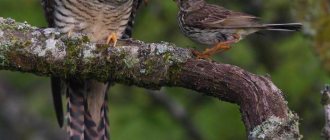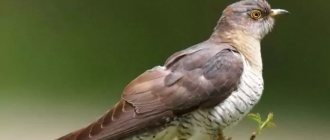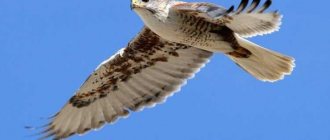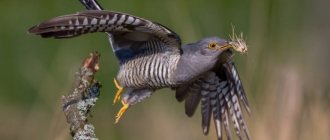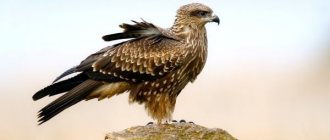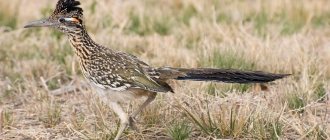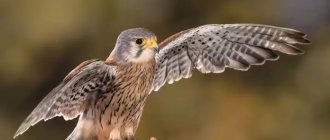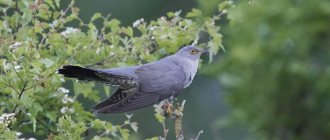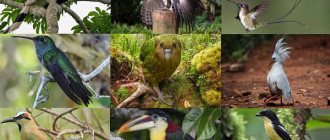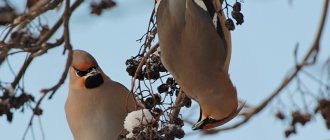- Reports and messages
- Birds
- Cuckoo
Every person knows such an interesting bird as the cuckoo.
Many were unable to see her, but her singing can be heard throughout the entire area. It's nice to hear the cuckoo's song while walking through a forest or park. Many representatives of the cuckoo genus, and in principle, do not like other birds. They try by all means to avoid noisy places. As for food, the cuckoo is not picky about this. It feeds on many insects, especially their larvae. The cuckoo's favorite delicacy is the furry caterpillar. Other birds do not like to eat these insects, but the cuckoo does not disdain, but on the contrary, looks for this food for itself. By eating this pest, the cuckoo is one of the most useful birds. In addition to the cuckoo, he also loves caterpillars and the oriole. Together, these birds do great good for nature and forests. When there are a lot of caterpillars, this threatens large areas of the forest, cuckoos fly to the rescue, thanks to their gluttony, they destroy many hairy caterpillars. Since ancient times, the cuckoo has been an example of improper upbringing. This is due to her lifestyle and raising offspring. These birds do not hatch eggs, nor do they even build nests. It’s easier for her to place her finished egg in the nest of some other bird, and let her raise her baby. Their eggs are always similar to those into which she is going to slip her foundling. Therefore, in certain places of its habitat, the bird has adapted to lay eggs exclusively to one species of bird. Somewhere this will be the nest of a robin or bunting. But in another place the cuckoo will throw an egg into the nest of a wood pigeon or wren. The cuckoo always lays a lot of eggs, and if she raised her chicks herself, she would not be able to cope. Therefore, it is easier for the bird to throw its young into another nest. The most interesting thing is that if new parents notice the substitution, they will throw the egg out of the nest, and if they don’t notice, they will raise it as their own. The cuckoo chick has also adapted to life. Its color takes on the shade of its adoptive parents. When the chick grows up, it throws other chicks out of the nest. It turns out that the foster family is raising only him. The cuckoo has adapted to lay only one egg in each nest, this gives it the opportunity to save more chicks. First, she looks for a new nest, after which she takes her egg in her beak and transfers it to a new place. Although it is interesting that almost all cuckoos raise their own chicks, but only the common cuckoo continues to throw eggs into other people's nests.
The cuckoo is a rather inconspicuous bird with a small body size. She does not have bright, beautiful plumage; she can only be recognized by her beautiful singing in the forest. This is a migratory bird. With the arrival of cold weather, it goes to warm countries for the winter, and in the spring it can again be heard among dense forests. The males return first; this time falls in the month of April. They are looking after good territory. A few days after this, the female cuckoos also fly back home. With the return of the cuckoos, it’s as if real spring begins, brightened by their beautiful song.
for grades 1, 2, 3, 5, 7, the world around us, briefly
What does the forest bird cuckoo look like: description, its size, close-up photo
forest bird cuckoo
Read an article about the Peregrine Falcon bird on our website . It contains information about the appearance, behavior of this predator, nutrition and various interesting facts.
The cuckoo is a member of a large and diverse family of cuckoos, numbering about 140 species . These birds live in all parts of the world, except Antarctica . What does the bird look like? Description, its dimensions:
- Cuckoos that live on different continents vary in size and color.
- The smallest species have a body length of 15 cm , and the largest reach more than 60 cm .
- The color ranges from monochromatic gray to motley-spotted with brown, orange, and even green splashes.
Here's a close-up photo:
forest bird cuckoo
The most famous and widespread species in our forests is the common cuckoo (lat. Cuculus canorus ). It is thanks to the mating song “Ku-ku, ku-ku” , the male of this species, that the family owes its name.
Continuation:
- The common cuckoo is a small, well-proportioned bird, with an average weight of 140 g (100-180 g) , a total length of 32-34 cm , and a wingspan of 55 to 65 cm .
- Males are slightly larger in size and weight than females.
- The color of female and male individuals is different. The male is dark gray in color, the lower chest is white with dark stripes, and the throat area is ash-gray. The tail feathers are whitish-gray with a distinct white tip.
- Females of the species have two colors. Some are very similar to males, but have brownish feathers on the back and throat.
- The second ones are very different in color: a dark orange back and a white chest with dark transverse stripes. The tail is wedge-shaped, measuring 11-15 cm.
- The wings are long ( up to 20 cm ), pointed at the end, gray with a brown tint.
- The cuckoo's legs are small, yellow in color, and have long, hard feathers ending at the very toes with sharp claws.
- The arrangement of the toes on the paws: two look forward, and two look back - helps the bird to sit steadily on the tree, tenaciously grasping the branch.
- But with such legs it is difficult for the cuckoo to move on the ground.
- The small dark beak has the shape of a hook, curved down.
- The eyes are yellow or gray, surrounded by a leathery orange ring.
- Despite the fact that it is rare that no one has heard the cooing, the bird is mostly silent.
- The cuckoo's song can be heard during the mating season from May to July .
In nature, the cuckoo lives for about 10 years .
Character and lifestyle of the cuckoo
Studying cuckoo behavior is a thankless task. She is secretive and cautious, leaving almost no traces of her activity. Loudly notifies of presence, but does not allow surveillance. You may not be able to distinguish many bird voices; even a child can recognize a cuckoo.
The photo shows a common cuckoo
The bird is not adapted to movement on the ground. If it descends for prey, it hurries to fly back. Two-fingered paws clumsily carry the cuckoo, whose step alternates with a jump. The required distance is missed to the target so that not even paw marks remain. A selected caterpillar or worm is a reward for the inconvenience of moving.
Cuckoos live separately, seeking to create pairs only temporarily for the mating season. The territory of each bird is proportional to its size and age. The male may “give way” to the female a little, but he protects the area from others and loudly notifies everyone.
In the nests of which birds does the cuckoo lay eggs?
The cuckoo lays eggs in the nests of various birds.
Cuckoos do not nest or build their own nests, being nest parasites. This is due to the physiological characteristics of the bird. The cuckoo does not lay eggs simultaneously, like many birds, but with an interval of 3-5 days . Over the summer, the female is capable of laying 10-15 eggs , and to hatch the chicks she would need to remain in the nest for 2 months In addition, the bird simply could not feed such a number of cuckoo chicks. Therefore, to raise its children, the cuckoo selects adoptive parents for them:
- The cuckoo does not lay its egg in the first nest it comes across, but carefully selects future educators for its offspring.
- Moreover, the search for a suitable pair begins at the stage of nest construction.
- More often she tries to leave her egg to the species of birds that she herself was fed.
- When laying an egg, the male helps the female.
- He flies around someone else's nest, pretending to be a predator and driving away the owners.
- As soon as they fly away, the female cuckoo lays her egg in the nest, it only takes her 15 seconds .
- Simultaneously with laying its own, the cuckoo destroys the host egg.
- The bird throws only one egg into each nest. Therefore, future parents, returning to the nest, do not notice the substitution and continue to hatch the chicks.
- The emerging cuckoo gets rid of both the eggs and the already hatched chicks, remaining the only subject of care for the adoptive parents.
In the nests of which birds does the cuckoo lay eggs? The adoptive parents of cuckoos are a large number of different birds that feed the chicks by placing food in their beaks. More often the parents of cuckoos are:
- Wagtails
- Kamyshovki
- Robins
- Flycatchers
- Warblers
- Finches
- Swifts
- Sparrows
- Finches
- Mints
- Redstart
- Other birds of the passerine family
Evolutionary development has endowed the cuckoo with the amazing ability to lay eggs that repeat the size or color of those in which they are laid. Therefore, the eggs of the common cuckoo differ significantly in size, from 15 to 23 mm , and color - 1117 species (from white to deep blue, large and small spotted).
How does a cuckoo chick grow?
When the cuckoo chick grows, it pushes all the other eggs out of the nest.
In total, 11-12 days , so its chick hatches earlier, beginning its struggle for survival. How does a cuckoo chick grow?
- The cuckoo chick is born completely blind and naked, there is no embryonic down, the weight is 2.5 -3.5 g .
- For the first 4-5 days, foster parents not only feed, but also warm the baby.
- As soon as it is born, the cuckoo chick tries to get rid of eggs or already hatched chicks.
- He pushes the eggs of his adoptive parents over the edge of the nest.
- In a similar way, he positions himself under the chick, pushing it towards the edge, and throws it out.
- He performs all his actions involuntarily; this instinct manifests itself in the cuckoo for the first 4 days , disappearing subsequently.
- The chick is unusually gluttonous. Moreover, in order to stimulate its adoptive parents to intensive feeding, the cub emits special loud cries that imitate the voices of the host chicks.
These loud calls often attract predators, who destroy birds' nests and kill their chicks. Although the chicks begin to fly at the age of three weeks, they continue to feed at the expense of their caregivers. Only six weeks after birth, cuckoo chicks leave the nest of the parents who fed them.
Social structure and reproduction
Photo: Little Cuckoo
Common cuckoos are completely solitary and polygamous. They do not gather in flocks, and pairs form only for one season. But at the same time, the mating rituals of these birds are quite filled with romance. Usually the male waves his tail like a fan and invites the female. Her lowered head and wings are signs of recognition and calling. The male may also bring a gift of a twig or stem as a sign of attention. Reproduction occurs from mid-spring to mid-summer.
Cuckoos do not have a nesting territory in the generally accepted sense. In the same area you can find one female and several males, and vice versa. A nesting area can be considered an area where a female cuckoo looks for other people's suitable nests in order to lay her eggs in them, one in each. But sometimes two females are found in the same area. In this case, they parasitize birds of different species.
Interesting fact: The incubation period of common cuckoo eggs is 11, less often 12 days. Therefore, the cuckoo baby is born earlier than its half-brothers and gains a significant advantage over them in the fight for food brought by its adoptive parents.
For the first four days, the behavior of the chick is aimed at displacing the remaining eggs and hatched chicks from the nest. The cuckoo sits under another chick, and then backs away to the edge of the nest, where it sharply straightens up so that the victim flies down. He does this instinctively, and after four days the instinct disappears.
The independent existence of the cuckoo begins 40 days after hatching, when the bird's plumage is fully formed. Until this time, the chick eats its adoptive parents. Feeding occurs constantly, even when the cuckoo grows larger than the birds feeding it. The cuckoo chick can leave the nest even after 20 days, but due to the fact that it makes characteristic cries asking for food, its foster parents continue to feed it even after that.
What kind of birds does the cuckoo belong to: genus, species
Cuckoo
More detailed information about the species of these birds. Common cuckoo:
- Genus - cuckoos
- Subfamily - true cuckoos
- Family - cuckoo
- Order – cuckoo-shaped
- Class – birds
The cuckoo family includes 6 subfamilies, 28 genera and more than 140 species . Cuckoos are the most numerous genus, with 15 species , including the common cuckoo.
Population and species status
To date, almost all representatives of this family have received the protection status of “Least Concern”, so this species of birds has no other statuses and this is not at all surprising.
Despite this optimism, the Bearded Cuckoo has found itself on the brink of extinction as these birds have lost their traditional habitats. Nowadays, experts are thinking about how to recreate the numbers of these birds, returning the indicators to previous levels.
Is the cuckoo a migratory bird or a resident one?
Cuckoo is a migratory bird.
Cuckoos are migratory birds. They are not sedentary. more than 3-4 months in their breeding areas . 6 thousand kilometers to their wintering grounds about 80 kilometers per day . Thus, they spend 2-2.5 months .
The common cuckoo chooses wintering sites:
- African countries
- India
- Southern territories of China
- Ceylon
When choosing a wintering place, cuckoos try to find settlements similar to their native ones, so they never winter in the desert. Interestingly, adult birds fly away for the winter immediately after laying eggs. That is, a month earlier than young cuckoos, which leave for migration at the end of August - beginning of September, and independently find their way to wintering places.
Lifestyle and habitat
Birds have chosen many habitats, covering almost the entire globe, except Antarctica and Antarctica. Cuckoos spread massively across the American continent and Eurasia.
Birds are attracted to the warm climate and areas with extensive deciduous forests. They do not like dense taiga with impenetrable thickets of dark coniferous plants. In many sparse forests, most species of cuckoos have colonized the upper layers of trees, only a few have settled in the forest-steppe. Evolution has gradually adapted birds to open spaces.
determine whether a cuckoo is a migratory bird or not by looking at its nesting site. Those species that hatch their chicks in the temperate zone fly to Africa, China, and India for the winter. Birds of North America migrate to Argentina.
During seasonal migrations, cuckoos travel more than 3,000 km without rest; the total distance from nesting sites reaches 6,000 km. Tracking migrations is difficult due to the secretive nature of the birds. Cuckoos do not flock together.
They fly slowly, conserving their strength. Wintering in the southern regions lasts approximately 3 months. In the tropics, the cuckoo is a wintering , sedentary bird.
Despite the prevalence of cuckoos, they are difficult to observe. They lead a solitary life, only breeding time attracts them to each other. Birds know the forest and the birds inhabiting it very well. The survey of the territory is measured in hectares.
As a nesting parasite, the mysterious cuckoo bird selects foster parents for its offspring. Hundreds of bird species became unwilling guardians. The cuckoo itself does not bother building a nest or caring for the chicks. It is no coincidence that the name of the bird has become a household name for grief-stricken mothers who abandoned their own children.
Among the numerous species there are many tropical cuckoos that are quite capable of feeding and raising offspring. Therefore, all birds should not be considered parasites. The social benefit of birds is the destruction of forests and gardens from harmful insects and caterpillars.
Is the cuckoo bird harmful?
Cuckoo
There are no useless animals or plants in nature. Although seemingly harmful at first glance, they turn out to be an important part of the ecosystem.
So it is with the cuckoo - this not very large bird destroys a large number of forest pests. She has an excellent appetite: she can eat up to 100 caterpillars 1,500 a day Moreover, its food becomes harmful and poisonous insects that other birds do not eat:
- Ticks
- Pine silkworms
- Furry caterpillars
The cuckoo is considered the orderly of the forest. It almost completely clears its habitat of pests, and, like a wolf among animals, limits the bird population, maintaining its optimal level.
Where does the cuckoo live?
Photo: Cuckoo in nature
The range of all species of cuckoos extends to all continents, with the exception of Antarctica. Covers almost all climatic zones from forest-tundra to the tropics. The largest number of species is found in Eurasia and North America, mainly in tropical areas. Common cuckoos are common in northern latitudes. They inhabit most of Europe and Asia, are distributed from the Atlantic to the Pacific Ocean and are found even in the Kuril Islands, Commander Islands, Japan and the Korean Peninsula. The northern border of the range of common cuckoos coincides with the border of the distribution of woody vegetation.
Common cuckoos are typical migratory birds. They do not stay in nesting areas for more than three to four months throughout the year. The distance to winter places from nesting sites of cuckoos can reach 5–6 thousand kilometers.
For wintering they usually fly to southern regions, such as:
- Africa;
- India;
- Southern China.
Common cuckoos prefer to settle in deciduous forests, less often in bush thickets on rough terrain, in forest belts or on island forests in the forest-steppe. Cuckoos avoid taiga and coniferous forests. In Central Asia, in places where there is very little woody vegetation, they can settle in open landscapes if there are isolated trees or shrubs nearby.
Common cuckoo bird: interesting facts
Common cuckoo bird
The name “cuckoo” comes from the well-known song “cuckoo, cuckoo” , which is not similar to the singing of any other bird. You will find other interesting facts about the common cuckoo bird below.
The bird, known in the world since ancient times in different countries, has a similar name, similar to the sounds it pronounces:
- In Bulgaria it is called “kukovitsa”
- Germany – “kukuch”
- Czech Republic - “kukača”
- Romania – “kukul”
- Italy - "cuculo"
Latin name: Cuculus canorus
, comes from two words:
Cuculus (cuckoo) and canorus (melodic; from canere - to sing).
The most interesting features distinguish the common cuckoo:
- From year to year, the cuckoo returns to its previous place of residence, and precisely to its territorial area.
- The bird is subject to molting twice a year: partial - in summer and full - in winter.
- If it is impossible to lay an egg directly into the nest, the bird can lay it nearby, and then, taking it in its beak, deliver it to the nest of the chosen future parents.
There have been cases of laying eggs in this way even in tree hollows.
Habits of an interesting cuckoo bird: description
Habits of an interesting cuckoo bird
The cuckoo leads a diurnal but secretive lifestyle. She is very careful, hides among the branches of tall trees and flies away when people approach. Most of the time the cuckoo is engaged in obtaining food, living in dense thickets, only occasionally descending to the ground for prey. Due to the structural features of its paws, the bird practically does not move on the ground and leaves no traces there. But she feels great in the air, her flight is distinguished by ease and swiftness. Here is another description of the habits of the interesting cuckoo bird:
- She is silent for the vast majority of the year and prefers a lonely, solitary existence.
- This way of life is disrupted only during courtship, from the end of spring until almost the end of summer.
- At this point, the birds begin to show interest in each other, forming seasonal pairs.
- During mating games, fierce fights between males occur. The birds become noisy, spreading their tails like a fan, trying to attract the attention of females.
- The famous “coo-coo, peek-a-boo” is the dominant mating song of the male.
- Females also sing during this period, but their singing is compared to a gurgling trill or a low vibrating whistle.
The birds' songs are loud, audible at a distance of two kilometers, long and sonorous for the male, quieter for the female. The couple’s relationship is characterized by romanticism: in gratitude for the choice, the male gives his chosen one a stem or twig.
Cuckoo's secrets
In spring or early summer, everyone heard a mysterious cooing in a forest or park. But few have seen this vocal bird, indistinguishable among the branches and cautious in its habits. The peculiarities of the bird's singing are reflected in the name, and in different European languages. The slightly sad “peek-a-boo” is even associated with wishing for fortune.
Bird of the cuckoo family: what does it eat?
Bird of the cuckoo family
cuckoo family is omnivorous birds. They can eat food of both animal and plant origin. What do they eat? The main part of the animal diet consists of insects:
- Caterpillars
- Beetles
- Mosquitoes
- Grasshoppers
- Slugs
- Ticks
- Spiders
- Ant larvae
- Snails
- Butterflies
- Worms
In addition to insects, certain types of cuckoos prey on young lizards, snakes, frogs, small rodents, and they are not averse to feasting on bird eggs. And, although cuckoos prefer animal food, their diet may include fruits of various shrubs and trees. Worth knowing:
- Cuckoos, unlike other birds, are able to use poisonous insects as food, including hairy caterpillars covered with poisonous chitinous hairs.
- The venom of the caterpillars is destructive to almost all birds; only cuckoos and orioles eat them.
- They have adapted to remove the poisonous gut of an insect before eating it.
- Cuckoos, although small, are very voracious birds.
- They devote all their free time to searching and eating food.
- And if it were not for the cuckoos, which are capable of destroying one and a half thousand caterpillars, beetles and larvae per day, the trees would be left without foliage. Their excessive appetite helps to accumulate subcutaneous fat necessary for flight during migration.
Cuckoos look out for their prey while sitting on a tree. Having good eyesight, they are able to see it at a distance of 45 m . Cuckoos are able to catch and eat an insect both on the fly and by picking it up from a tree or ground.
What bird looks like a cuckoo?
The dove is similar to the cuckoo.
The cuckoo has similar features to many birds. What bird looks like a cuckoo?
- Even in ancient times, its resemblance to a hawk was noted. Indeed, the appearance of the bird: the color of the plumage, the shape of the head and the flight style are reminiscent of a falcon or a hawk. This similarity helps the cuckoo to scare away birds in whose nests it intends to lay its eggs.
- The bird resembles a pigeon in size, but has a more aristocratic build.
The structure of the cuckoo's paws with diametrically opposite toes makes it similar to woodpeckers, owls or parrots.
Natural enemies
Adult cuckoos have very few enemies, which is due to their secrecy, agile and fast flight, as well as their external similarity to species of birds of prey. In some circumstances, cuckoos can become victims of:
- Orioles.
- Warblers.
- Sorokoputov.
- Gray flycatchers.
Bird - oriole
Usually collisions occur among chicks, which are not yet experienced and strong enough to withstand the predators attacking them.
In addition to birds of prey, mammals such as foxes, weasels, and martens also pose a danger to cuckoos. However, this problem practically does not concern agile birds, since they rarely descend to the ground and behave extremely carefully.
The danger for cuckoos lies not only in attacks on young individuals, but also in the destruction of nests where the eggs were thrown. This can be done by crows or jays, which can eat eggs and kill small chicks when foster parents cannot prevent this.
Which trees does the cuckoo like to sing on: birch
The cuckoo loves to sing on the birch tree.
As you know, the cuckoo sings only during courtship, therefore its singing places are limited to the zone of subsequent distribution of laid eggs. In which trees does the cuckoo like to sing?
This cautious bird prefers to settle in mixed forests. Observing silence and caution, the cuckoo can be seen at the forest edge, sitting on a birch tree. The bird is also often spotted on larch, rowan, pine, and willow. If you see a tree with a lot of caterpillars in the forest, know that a cuckoo is nearby and will definitely come to the rescue.
